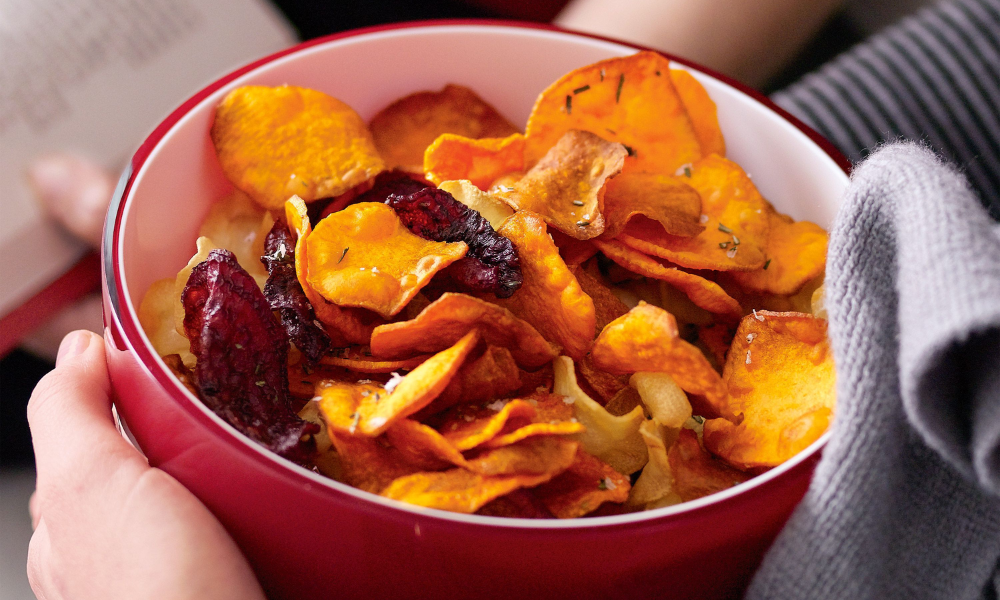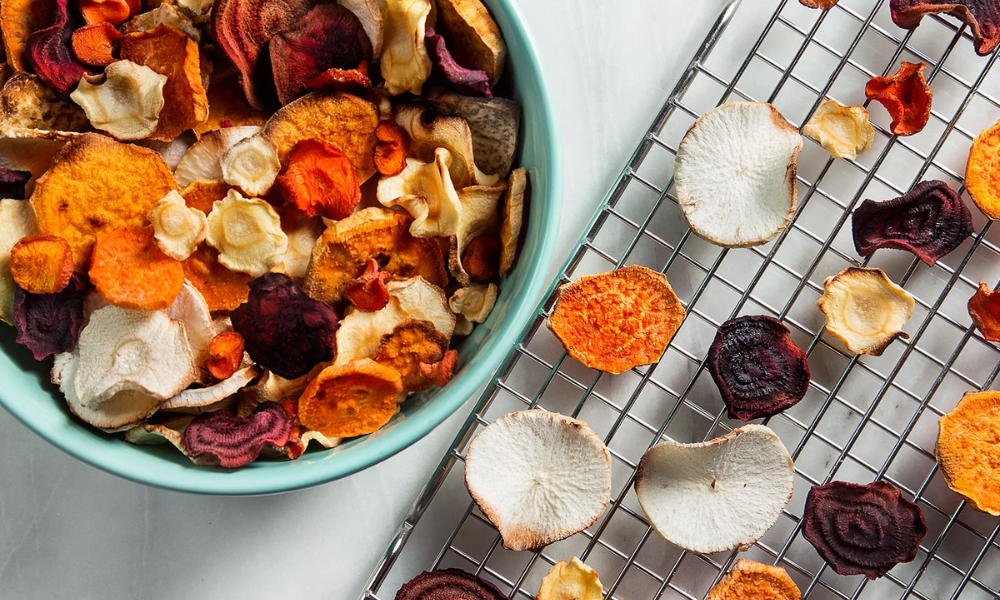Crispy Baked Vegetable Chips come together quickly and are the ideal crunchy snack for lunch boxes or movie nights. Vegetable chips (also known as veggie chips) are chips (crisps) made from vegetables other than potatoes. Fried, deep-fried, dehydrated, dried, or baked vegetable chips are all options. Many different root and leaf vegetables can be used.
Vegetable chips can be eaten as a snack, as an accompaniment to other foods such as dips, or as a topping on dishes. Vegetable chips are frequently mass-produced in the United States, with numerous brands marketed to consumers. While potato chips are technically considered “vegetable chips,” because they are the most common type of chip, any other vegetable-based chip is classified separately.
What Exactly are Chips?
A chip or crisp is a bite-sized snack food that is crisp, flat, or slightly bowl-shaped. Some chips can be formed into dishes and served as an appetizer, side dish, or another similar dish. Since they are the most popular type of chip, potato chips are technically considered “vegetable chips,” but any other vegetable-based chip is categorized in a different category.
Some types of chips are frequently served in the chips and dip combination plate. Other chips are too sweet, too flavored, or too fragile. Tortilla chips can be used to make chips and salsa, nachos, bean dip, guacamole, or a layered dip with several of these ingredients.
How to Make Vegetable Chips?
These vegetable chips are a crunchy, crispy, guilt-free snack that only takes 20 minutes to make! Low in calories and fat, and far superior to store-bought. Making your own vegetable chips, whether fried or baked, is simpler than you might think. You also get to choose the vegetables and seasonings for your homemade veggie chips.
Carrots, parsnips, potatoes, and beets are the best root vegetables. The vegetables are peeled and thinly sliced before being soaked in water. They are fried, kept warm, and then tossed with seasoned salt after being drained and dried.
Ingredients:
- 1 large carrot, peeled and trimmed
- 1 large trimmed parsnip
- 1 medium sweet potato
- 1 potato, Yukon Gold
- 1 canola oil from a large beet
- 2 tbsp. kosher salt
- 1 tablespoon garlic powder
- 1 tablespoon onion powder
Instructions:
- Gather your ingredients. Peel the vegetables. Cut the vegetables into very thin slices (1/16-inch thick) using a mandoline, a food processor fitted with a 2 mm slicing blade, or a sharp knife.
- Fill a large bowl halfway with ice water and add the carrots, parsnips, sweet potatoes, and Yukon gold potatoes. Fill a small bowl with ice water and add the beet slices. Allow the vegetables to soak in the water for 30 minutes.
- Line two baking sheets with several layers of paper towels. Drain the vegetables and lay them out on the towels in a single layer. Pat the vegetables dry to remove any excess water.
- Preheat the oven to 200 degrees Fahrenheit. 2 paper towel-lined plates In a heavy-bottomed Dutch oven, heat 3 inches of oil over medium-high heat until it reaches 350 F on a deep-frying thermometer. This will take approximately 8 to 10 minutes.
- Fry about 1/2 cup of vegetable slices in the oil for 2 minutes, or until crisp and golden brown. Transfer the vegetables to a plate lined with paper towels to drain.
- Remove the paper towels from the baking sheets and arrange the fried vegetable chips on them in a single layer. To keep the warm, place it in the oven. Repeat with the remaining vegetables in batches, keeping the oil temperature at 350 F.
- Prepare the seasoning mixture: Combine the salt, garlic powder, and onion powder in a small bowl. Toss the warm chips with the seasoning mixture in a large mixing bowl. Serve immediately.
Are Dried Vegetable Chips Healthy?
Vegetables are a good choice for a healthy snack because they are low in calories and high in fiber. Many dried vegetable chips, on the other hand, may not be as healthy as their source vegetable, but they are better than a traditional potato chip.
Veggie chips aren’t any “healthier” than potato chips, so choosing one over the other is pointless. Choose fresh vegetables with hummus, homemade vegetable chips, or a handful of lightly salted nuts to replace processed snacks without sacrificing salt and crunch.
You’re walking down the snack aisle, past all the tempting bags of chips, when you notice them: Veggie chips. They could be little stick puffs or actual chips in a variety of cool root-vegetable colors. However, the ingredients list a variety of non-potato vegetables, and the packaging informs you of all the healthy ingredients contained within. Despite this, they taste too good. If you’re trying to incorporate more vegetables into your diet, switching from regular potato chips to veggie chips may appear to be a simple solution.
What Makes up the Majority of Vegetable Chips?
Potatoes, oil, and salt are common ingredients in potato chips; veggie chips are no different, save for the type of vegetable used. The types of oil differ depending on the brand. Popular vegetable chip brands use canola, safflower, or sunflower oil (or a combination of these oils).
Veggie chips are made from a variety of vegetables, including squash and green beans, as well as root vegetables such as purple and orange sweet potatoes, taro, and carrots. The vegetables are thinly sliced and lightly fried until they are delightfully crisp. This snack, on the other hand, is primarily made of potato starch, potato flour, and a combination of vegetable oils, making it nutritionally comparable to regular potato chips and tortilla chips.
Are Vegetable Chips Low in Carbs?
Veggie Chips are not keto-friendly due to their high carbohydrate content and the presence of maltodextrin, canola oil, and corn oil. They’re an excellent low-calorie, low-carb, and gluten-free substitute for regular chips. Veggie chips should be avoided on keto because they have a high net carb count (46.43g of net carbs per 100g serving). To stay in ketosis, limit your net carb consumption to 20g – 30g per day. Using this keto macros calculator, you can calculate your ideal daily net carb allowance.
You could also look for other snacks that are low in net carbs. Veggie Chips are made with highly refined canola oil, corn oil, and sunflower oil. These refined oils are prone to oxidation and may cause inflammation in the body. Highly refined oils are typically extracted using high heat and chemicals. This process removes the nutrients from the oil and replaces them with harmful chemicals. It is critical to get your fats from healthy sources so that your body can burn clean fuel while in ketosis. You can see our list of the best and worst keto oils here.
How do you Make Vegetable Crisps in a Dehydrator?
In a sizable mixing dish, combine all the vegetables. Sprinkle the slices with rosemary, salt, and olive oil. Place in a single layer on your dehydrator trays after being completely covered. Chips are dehydrated at 135°F for 8 to 12 hours, or until crisp and light.
A dehydrator can enable you to indulge in crunchy, salty, or sweet treats like fruit and vegetable chips guilt-free. Dehydrate your preferred fruits or vegetables after cutting them up and seasoning them with your preferred spices.
Utilize your dehydrator to make veggie chips. Utilize the summer’s plentiful supply of kale and other lush greens by turning them into nutritious chips. Making your own kale chips is more affordable and healthier than purchasing them at a health food store. Additionally, you can make chips using veggies like zucchini, radishes, or carrots.
Are Veggie Chips Good for Diabetics?
One of the simplest and healthiest low-carb snacks you can make yourself is baked zucchini chips. They are flavorful and the ideal crunchy snack for those with diabetes because they are low in sugar. they have carbohydrates, but if you watch your portions, you can still consume them on a diabetes diet. They have a respectable level of fiber and protein as well as almost no fat (and no saturated fat). They also have a very low salt content.
The main line is that neither potato chips nor veggie chips are particularly “healthier,” and thus it is pointless to choose one over the other. Choose raw vegetables with hummus, homemade vegetable chips, or a handful of mildly salted nuts as an alternative to packaged snacks if you don’t mind sacrificing salt and crunch.
Conclusion
The vegetable chips are strategically marketed as a more natural, wholesome, and nutritious chip. Vegetables are high in fiber, vitamins, minerals, and antioxidants, and we know that eating a variety of them on a regular basis can help reduce the risk of chronic diseases, obesity, and cancer. However, it’s critical to remember how these chips are made. Here’s what you need to know about veggie chips and how they stack up against whole vegetables. Many crunchy “veggie straws” and some chips, for example, are made from powdered vegetables and other additives, resulting in a product that is low in fiber, protein, vitamins, minerals, and actual vegetables.
“Foods with a health halo don’t necessarily translate into foods that are nutritionally superior,” Harb street says, citing the example of veggie chips versus regular potato chips. If you prefer veggie chips for the novelty, variety, and earthier flavor, that’s fantastic. If you prefer regular potato chips, this is an equally fantastic and acceptable alternative. Many of these vegetable chips are dehydrated, which preserves most vitamins and minerals (except vitamin C) and some fiber.

